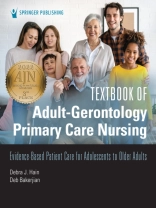‘I was thrilled to see content that focuses on quality improvement, patient safety, interprofessional collaboration, care coordination, and other content that supports the role of the AGNP as a clinical leader and change agent. The authors give these topics the attention that they deserve, with clear, insightful guidance and importantly, the evidence base. The chapters that address roles (including during disasters!), settings of care, billing, and medication use address salient issues that will help the fledgling AGNP to hit the ground running and the seasoned AGNP to keep current.
–Marie Boltz, Ph D, GNP-BC, FGSA, FAAN
Elouise Ross Eberly and Robert Eberly Endowed Professor
Toss and Carol Nese College of Nursing, Penn State University
From the Foreword
Written for Adult-Gerontology Primary Care Nurse Practitioners, faculty, and students, this primary text encompasses the full scope of AGNP primary care practice across multiple healthcare settings including telehealth. The text emphasizes the best available evidence to promote person-centered care, quality improvement of care, interprofessional collaboration, and reducing healthcare costs. The text delivers timely information about current healthcare initiatives in the U.S., including care coordination across the healthcare continuum, interprofessional collaboration, and accountable care organizations.
Disease-focused chapters contain general and specific population-based assessment and interprofessional care strategies to both common and complex health issues. They offer consistent content on emergencies, relevant social determinants of health, and ethical dilemmas. The text also prepares students for the administrative aspects of practice with information on the physical exam, medications, billing, coding, and documentation. Concise, accessible information is supported by numerous illustrations, learning objectives, quality and safety alerts, clinical pearls, and case studies demonstrating best practice. A robust ancillary package includes an Instructor’s Manual with case studies and teaching guides, a Test Bank reflective of clinical situations and patient conditions, Power Points covering key concepts, and an Image Bank of skin conditions and other figures.
Key Features:
- Covers several key courses in the curriculum for ease of teaching/learning
- Embraces a broad population focus addressing specific care needs of adolescents through older adults
- Facilitates safe care coordination and reinforces best practices across various health care settings including telehealth
- Fosters understanding, diagnosis, and management of patients with multimorbid conditions
- Incorporates evidence-based practice information and guidelines throughout, to ensure optimal, informed patient care
- A robust ancillary package includes an Instructor’s Manual, a Test Bank, Power Points, and an Image Bank.
लेखक के बारे में
Debra Bakerjian, Ph D, APRN, FAAN, FAANP, FGSA is a clinical professor at the Betty Irene Moore School of Nursing at the University of California, Davis. Her education and research interests focus on patient safety, quality improvement, interprofessional team-based care, geriatrics, and expanding the workforce in rural and underserved areas. Over the past decade she has taught geriatrics, patient safety, quality improvement, masters seminars, and leadership at the UC Davis. Dr. Bakerjian has received a variety of awards over the years; most recently she received the Dean’s Award for Inclusion Excellence in 2016 from UC Davis Schools of Health, the Distinguished Educator in Gerontological Nursing in 2019 from the National Hartford Center for Geriatric Nursing Excellence in recognition for her teaching, and the Dean’s Award for Research Excellence in 2021 from the Betty Irene Moore School of Nursing. Dr. Bakerjian is active in several state and national organizations associated with older adults, quality improvement, and patient safety. Most recently, she has written extensively about the impact of poor staffing and COVID-19 in nursing homes. She is a Fellow in the American Academy of Nursing, the American Association of Nurse Practitioners, and the Gerontological Society of America.












